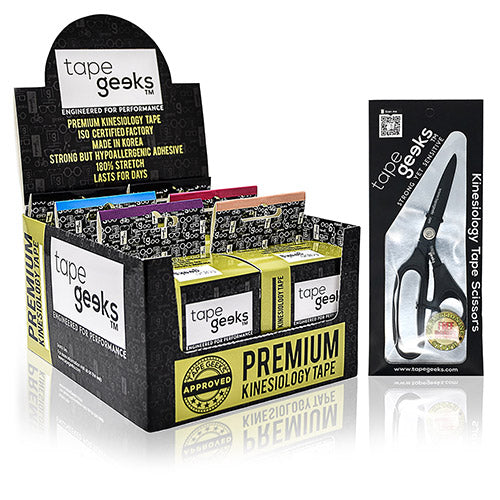
Wrist pain is a common condition that can impede daily activities when not addressed. With numerous possible causes, some of its most common ones is a sprain or tendonitis (or inflamed tendon).
In this article, we’ll talk about the possible causes of wrist pain, its symptoms, and how to prevent them in the future.

Shop our kinesiology tape now
Shop Now
What are the possible causes of wrist pain?
Some of the causes of wrist pain include:
- Wrist Sprain. A wrist sprain occurs when ligaments in the wrist are overstretched. When you have a wrist sprain, you may feel pain when moving, swelling in the joints, and bruising. You may also feel a burning/ tingling sensation.
- Wrist Tendonitis. Tendons connect your forearm muscles to your hand and finger bones. The flexor tendons allow you to grip objects, while the extensor tendons allow you to release objects. Wrist tendonitis happens when one or more of these tendons are inflamed.
- Wrist Fracture. Common among people with weak bones, a wrist fracture is another common cause of wrist pain. A common type of wrist fracture is a scaphoid fracture; it usually happens when you fall and try to catch yourself by outstretching your hand.
- Carpal Tunnel Syndrome. Caused by overuse, Carpal Tunnel Syndrome is commonly caused by repetitive movements leading to inflammation as well as scar tissue. Pinching the median nerve that runs through the wrist joint, causing pain.
- Arthritis. Certain types of arthritis affect the wrist. These include gout, osteoarthritis, and rheumatoid arthritis.
What are the symptoms of wrist pain?

The symptoms of wrist pain may vary according to its cause. Here are some of the common ones:
- Wrist sprain.These are some of the symptoms of an injury or sprain may include swelling and bruising in the area.
- Carpal Tunnel Syndrome.Some of the notable symptoms of this condition may include feeling numbness, tingling, and weakness in the hand.
- Other symptoms may include:
- Stiffness in the wrist and in the fingers
- Pain in the wrist when gripping or holding objects
- Clicking sounds when moving the wrist
How do you diagnose wrist pain?
Some of the ways that your healthcare may use to diagnose wrist pain are:
- X-ray
- CT scan
- MRI (Magnetic Resonance Imaging).
- Ultrasound
What are the ways that you can treat wrist pain?

Here are some of the available treatments that you can do that may help alleviate wrist pain, especially those caused by a sprain or tendonitis:
- Rest. Resting will help in reducing inflammation as you stop using the joint.
- Ice. Putting an ice pack on the area may also help alleviate pain. Make sure that you don’t leave the ice on for more than 20 minutes as it may damage your skin.
- Kinesiology taping. Applying kinesiology tape promotes blood and circulation in the area. By lifting the skin, the tape helps relieve the pressure and may help reduce inflammation and discomfort. Plus, putting on the tape helps provide support for wrist sprain without limiting movement.

Shop our bundles now
Shop Now
- Immobilization. Wearing braces or splints may help with carpal tunnel or wrist arthritis. By immobilizing the wrist, you help prevent doing certain movements that can cause irritation.
- NSAID. Nonsteroidal anti-inflammatory pain medications may help with wrist pain caused by a sprain, tendonitis, and arthritis.
- Corticosteroid injections. These may help with wrist arthritis or carpal tunnel syndrome.
- Surgery. Depending on the cause of the wrist pain, some cases may need surgery. Some conditions that may require an operation are certain types of fracture and ganglion cysts.
How do you apply kinesiology tape for wrist sprain?
Before your wrist application, here are some tips on how to prepare beforehand. And, since you’ll be applying different kinesiology tape tensions, learn more about it here.
Here is a kinesiology taping protocol that may help you relieve discomfort from wrist sprain:
- Prepare two strips of kinesiology tape.
- Bend your elbows, forming a 90-degree angle with your palms facing downward. Spread your fingers out.
- Have your assisting partner give the tape 50-75% tension on the tape and apply it on top of the wrists. Make sure to not put any tension on the ends.
- Next, check which motion causes pain and you’ll be applying tape depending upon it.
- If bending the wrist down hurts, you’ll want to resist that. Bring the wrist into an extended position and apply the tape with 50-75% tension on top of the hand. If bending the wrist back hurts, apply the tape on the opposite side.
- Rub in the tape to activate the adhesive.

Shop our kinesiology tape now
Shop Now
Tape Geeks: The best skin-friendly kinesiology tape for wrist pain!
When you’re using kinesiology tape to relieve discomfort brought about by wrist sprain or tendonitis, it’s essential to consider the quality of the kin tape that you’ll be using for the sake of your skin!
Taping shouldn’t just be about muscle and joint support. It should also be protecting your skin from unwanted rashes and allergies that may be brought about by low-quality adhesives.
This is precisely what Tape Geeks is all about!
Get the best deals for Tape Geeks' kinesiology tape by visiting our Amazon store today!
How do you prevent wrist pain?
While it’s hard to prevent wrist pain brought about by arthritis or cysts, there are some steps that you can take to prevent wrist pain brought about by overuse. Here are some basic steps that you can take to prevent wrist pain:
- Have an ergonomic work setup.Having a poorly set up workspace makes you more prone toworking aches and pains. Make sure that you arrange your workspace or desktop at an optimal position. Here’s a helpful video from WSJ to help you do just that!
- Maintain good posture.Check your posture and maintain proper form from head to toe. This will help you prevent wrist pain.
- Stretch regularly.When working, take regular breaks. Also, make sure to stand up and stretch in between work hours.
Conclusion
In this article, we’ve talked about the possible causes of wrist pain, its symptoms, and how to prevent them in the future. We’ve also talked about a kinesiology taping protocol for wrist pain that can help give support in the area and alleviate discomfort.
Be sure to check out the Tape Geeks blog for more helpful tips on preventing and treating various aches and pains like upper back pain as well as calf strain.
Thanks for reading!

Shop our collection now
Shop Now
Subscribe to the TapeGeeks Newsletter for new videos, discounts and more!Join The Geeks Club









